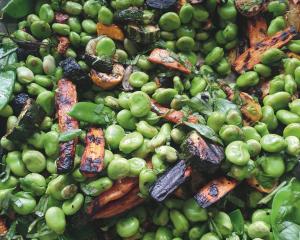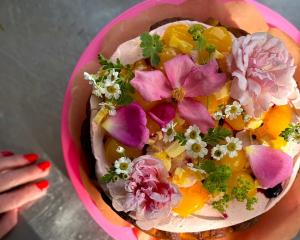
The quietly spoken Malay-born Chinese chef, now one of Australia's leading culinary figures and owner of the Unlimited Cuisine Company, has been called "a Renaissance man" for he has an academic background as well as a culinary one.
He describes himself as a "food freak with an acquisitive mind" and "very nerdy" and if he loves something he will go all out to learn it.
"You have to be very grounded in a cuisine first or you are not teaching the public the right thing," the culinary teacher, television food presenter and culinary tour leader, says.
A serious interest in food has been in his blood since childhood.
His parents had one of the best Chinese restaurants in Malaya, he says, his godparents were Indian, he was brought up with Roman Catholics, his neighbours were Malayan and one of his nephews married a Thai woman and another an Indian, which gave him access to many different cuisines.
His family would sit round the table, discussing the details of what made certain foods good, or not so good.
"It gets in your blood and it makes you understand more than the average person because it's always taken very seriously, and when you go to someone's house and you see your green papaya salad is not as good as theirs and you ask why and begin to understand," he says.
He has visited Vietnam regularly over many years, living with local families because he feels it's important to understand the grassroots of a cuisine before moving up.
He is adamant about researching a cuisine to the "nth" degree before he will teach it, and he likes to teach it carefully and respectfully but also be public-friendly and not intimidate people with too much detail and information.
However, he gets nervous about people mixing dishes as it does not do justice to a cuisine.
Flavours have to stay distinct, he says.
He is adamant, for example, that when making a particular chicken curry, the right Vietnamese curry powder - made by a Saigon man whose great-great-great-great-grandfather was Indian - should be used.
The curry also includes lemon grass, ginger and potato and is served with a characteristic salt, pepper and lime dip, a bowl of fresh herbs - and sliced baguette, a legacy of French colonisation.
Most of the Vietnamese restaurants in Australia and New Zealand serve south Vietnamese food because that is where the immigrants, the boat people came from.
Southern Vietnamese cuisine is tropical and uses spices that northern Vietnamese would consider too strong or heavy.
In the north, cuisine is influenced by the Chinese because they were colonised intermittently by the Chinese for about 1000 years.
"Its tradition is very much its own but at the same time it's heavily influenced by the use of yin and yang concepts. It's the only Southeast Asian nation that uses chopsticks."
North Vietnamese like to consider their food purer, but in Central Vietnam, the home of imperial cuisine, the food has a beautiful refinement, he said.
He demonstrated a squid stuffed with pork, glass noodles and wood ear mushrooms, that had its origins in the imperial cuisine.
When a cuisine is refined it moves beyond just being fuel and represents a culture, he says.
"It becomes even more important than just what we are putting on the tables. That's what refinement's all about.
"It teaches people a sophistication that eventually becomes a total experience - why is it you have to hold the chopsticks at this end, why you have to put your fork and your knife together rather than eating as if you are a caveman."
Tony Tan's Vietnamese stuffed squid or calamari (muc nhoi thit)
Serves 6
6 medium squid, each about 1kg (12-15cm long) cleaned. Reserve tentacles
oil for frying
stuffing:1 Tbsp oil
3 shallots, finely chopped
1 clove garlic, minced
1 birds-eye chilli, minced
300g minced pork
reserved tentacles, finely chopped
1/4 cup glass noodles, about 25g, soaked, drained and cut into 2cm pieces
1/4 cup carrot, about 25g, cut into fine julienne
5 dried wood ear mushrooms, about 20g, soaked drained and finely chopped
1 tsp Vietnamese five spice powder
1 Tbsp Vietnamese fish sauce
salt and pepper
1 tsp sugar
1 small egg, beaten
1 Tbsp coconut milk
To serve: Plenty of fresh herbs such as coriander, parsley, Vietnamese mint etc
To make the stuffing, heat oil and fry the shallots until fragrant but not brown. Remove and cool.
Then add to the rest of the stuffing ingredients. Mix well, fry a morsel and taste for seasoning.
Pierce or nick pointy end of each squid tube with a knife. (This hole acts as a vent to allow air to escape when stuffing and preventing the tube from exploding when cooking).
Fill the squid with the stuffing mixture, allowing room for contraction with cooking. Secure with a toothpick.
Repeat until all the tubes are filled. Heat oil in a pan and fry the squid until golden and cooked through, about 10-15 minutes. (Alternatively, bake them in an oven at 180degC for 10-15 minutes after the initial searing in the pan).
Remove from pan and leave to cool five minutes before slicing into rings. Serve at once with nuoc cham.
On the Net
For more information on Tony Tan and his cooking classes and culinary trips to Spain and China, visit www.tonytan.com.au











